Our name 20 Mondi refers to Italy’s 20 geographic/territorial regions, or, as we like to think of them, 20 culturally different worlds. It’s remarkable how familiar we are with some of their names, like Tuscany, Sicily, and Calabria, more so than the regions in other countries, but there are 20 regions and our job is to help you get to know them all.
The first thing to know is that “Italian” is not the only language. Today, over 40 different dialects are still in use. Sounds complex? More than you can imagine. To begin, let’s enter the local speak. We’ve prepared a super basic 101 to the 20 Worlds of Italy and we’ll be using the Italian spelling for the names of the regions, so instead of Tuscany we’ll be using the Italian Toscana. Don’t fret, we’ll help you with the pronunciation (see the “Fact Section” below each description). So let’s start with just a sip of each world:
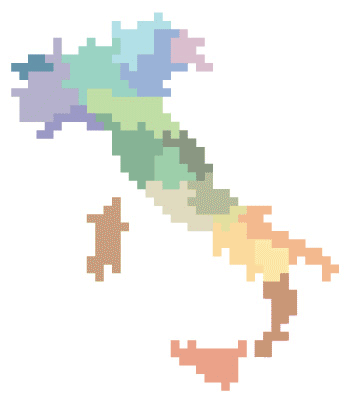
Driving through some of the highest mountain roads in the northwest corner of Italy, one passes towns with names like Pre-Sant-Didier and Courmayeur. Did we take a wrong turn? Are we in France, or French-speaking Switzerland? Valle d’Aosta does share borders with these two countries, an interesting fact for being Italy’s smallest, and least densely populated region. The US state of Rhode Island is about the same size geographically but has almost 10 times the population.
Valle d’Aosta is a land of grazing pastures, pristine forests, rugged snow-capped peaks and severe climates. An ancient proverb defines it as a “paradise for men, purgatory for women and hell for mules”. Isolated for centuries, the valleys have developed a cuisine based exclusively on local products, dominated by the alpine cow’s milk cheese Fontina. And the similar terrains of neighboring France and Switzerland definitely influence the language, customs and menus. Here we find the Prié Blanc grape, considered the highest altitude varietal in Europe, and the widely diffused red grape Vien de Nus.
Valle d’Aosta Fact Section
Pronounced: val-lay-DAH-osta
English name: Aosta Valley
Capital city: Aosta
Pronounced: AH-osta
English name: Aosta
Population: 128,000
Common dialects: 2
S
hares borders with: Piemonte, France, Switzerland
UNESCO heritage sites: 0
Official wine zones: 1 DOC
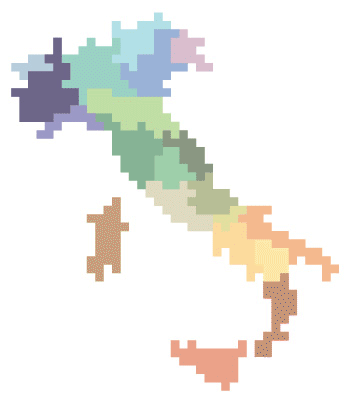
“At the foot of the mountains”. Piemonte truly lives up to its medieval Latin-based name, Pedemontium. Breathtaking views of the Italian Alps surround Torino, the region’s capital, famous for being the home of FIAT, the Italian car maker that helped put Detroit back on its feet. The Piemontese people are known for their pragmatic, non-indulgent disposition probably due to their long history as land workers, always under the rule of somebody else. Holidays were traditionally celebrated by slaughtering a pig and using every last bit, snout and ears to toes.
Slow Food, the respected global movement started in Piemonte, contrasting that, it’s also the birthplace of Nutella. Piemonte is Italy’s second largest region after Sicily, and with 75 per cent of its geography hills and mountains, it’s got what it takes to be a winemaker’s paradise. The Nebbiolo grape loves it here with the world renowned wines Barolo and Barbaresco as proof. We’ll be covering these mega-stars of this region but we’ll also be dedicating a good chunk to unsung heroes like Barbera, Ruchè and Arneis.
Piemonte Fact Section
Pronounced: Pee-ay-MOHN-tay
English name: Piedmont
Capital city: Torino
Pronounced: toh-REE-no
English name: Turin
Population: 4,393,000
Common dialects: 16
Shares borders with: Liguria, Emilia-Romagna, Lombardia, Val d’Aosta, France, Switzerland
UNESCO heritage sites: 5
Official wine zones: 17 DOCG and 42 DOC
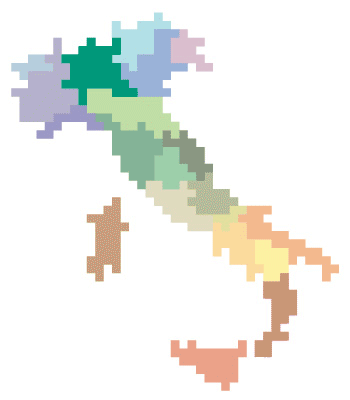
The Industrial Powerhouse of Italy – is a phrase that comes to mind, with good reason, when considering this northern region. So it may be a surprise to learn that Lombardia is also Italy’s most agricultural region when it comes to production of corn, soy, wheat, fruits, vegetables and wine. Most Italians also agree that Lombardia is the economic engine of Italy, and that Milan is the world’s capital of fashion and design.
Even Leonardo Da Vinci made some big bucks on commissions from Milan’s richest patron: the ruling Sforza family. He spent 17 years in Milan, hitting his stride and reaching new heights of scientific and artistic achievement. We’re wondering what wine he drank, inspiring him to paint 12 glasses of the stuff in his dry plaster painting, Il Cenacolo (or The Last Supper) at the church of Santa Maria delle Grazie in the historical center of Milan. Maybe it was from Croatina, one of the grapes we’ll be hunting down in Lombardia, along with Chiavennasca, Groppello and Trebbiano di Lugana.
Lombardia Fact Section
Pronounced: lohm-bar-DEE-uh
English name: Lombardy
Capital city: Milano
Pronounced: Mee-LA-no
English name: Milan
Population: 10,020,000
Common dialects: 22
Shares borders with:
Liguria, Emilia-Romagna, Lombardia, Val d’Aosta, France, Switzerland
UNESCO heritage sites: 10
Official wine zones: 5 DOCG and 21 DOC
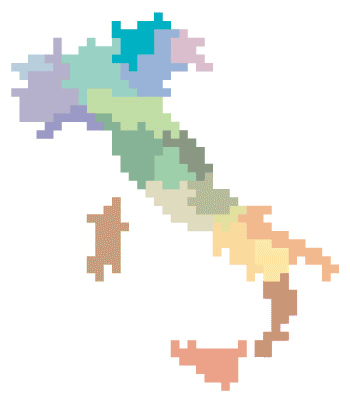
Wohin man schaut, dominieren die massiven Dolomiten… uh, sorry to throw you a curve ball there, but we’re prepping up to be part of the scene when we visit this most northern and mountainous Italian region. Trentino-Alto Adige is autonomous, one of 5 autonomous regions in Italy, allowing its administration to mandate basic norms of northern European efficiency, making it Italy’s most forward thinking region in general business practices and in the area of “green” economies. It’s divided into two provinces, and shamelessly flaunts its split personality. Two languages, two distinct cultures. The northern Alto Adige or Sudtirol – as it shares its border with North Tyrol of Austria – speaks predominately German as it was part of the Austro-Hungarian Empire until 1919. (It surprises most outsiders that Italy, regardless of its long important history, is actually a very young unified country.)
We are planning to pay a visit to Trentino-Alto Adige’s most famous resident, Oetzi, who, while traveling the Alps about 5300 years ago was hit by an arrow. The ice mummy, as he’s known, was found on a glacier here in 1991 and now rests in the Sudtirol Museum of Archaeology.
Trentino is the southern half of the region. Its residents, called Trentini, are a bit more “Italian” but are still considered Krauts by their southern regional neighbors. They are also the Johnny Appleseeds of Italy, growing lots of apples, nearly 340,000 tons a year. But we’ll be there for the grapes. Trentino-Alto Adige produces some of the most elegant reds and whites in Italy due to its favorable climatic and elevation factors. Teroldego, Lagrein and Nosiola are on our list.
Trentino-Alto Adige Fact Section
Pronounced: tren-TEE-no, alto-AH-dee-jay
English name: Trentino South Tyrol
Capital city: Trento
Pronounced: TREN-toh
English name: Trento
Population: 1,070,000
Common dialects: 3
Shares borders with: Lombardia, Veneto, Austria, Switzerland
UNESCO heritage sites: 2
Official wine zones: 9 DOC
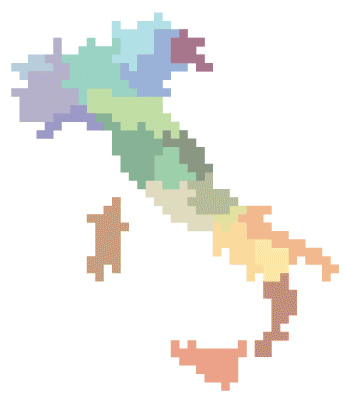
Another region with multi-international borders and an autonomous status, Italy’s northeastern extremity is a neighbor of Austria and Slovenia and the Italian region of Veneto. The hyphenated name is a result of two historically different regions, making Friuli-Venezia Giulia a fascinating, complicated land.
Despite being so close to Venice, one of the most popular tourist sites in the world, F-VG remains surprisingly off the radar with rarely visited warm sandy beaches, snow capped mountains, lagoons with water birds, Roman ruins, busy international sea ports, excellent coffee, palatial country villas, remote alpine hamlets, panoramic fishing villages and, oh yes, the wine. Arguably some of the best whites in Europe, nick-named “Super Whites”, are made here. We’ll be hunting down the grapes Tazzelenghe, Picolit, and the fruity red Refosco. Book your flight.
Friuli-Venezia Giulia Fact Section
Pronounced: free-YOO-lee vay-NAY-zee-uh JOO-lee-uh
English name: Friuli-Venezia Giulia
Capital city: Trieste
Pronounced: tree-ESS-tay
English name: Trieste
Population: 1,218,000
Common dialects: 17
Shares borders with: Veneto, Slovenia, Austria, Adriatic Sea
UNESCO heritage sites: 5
Official wine zones: 4 DOCG and 12 DOC
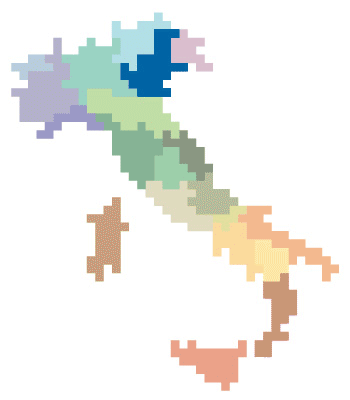
Here lies one of the most beautiful cities in the world: Verona. Okay, beauty is in the eye of the beholder. Most people will say Venice. But we do prefer the wines of the Verona area. The Valpolicella appellation produces the great red wine Amarone made with the autochthonous grapes Corvina and Rondinella. After a magical summer’s evening of opera at Verona’s Roman amphitheater, having a pizza and a glass of Amarone while sitting in Piazza Bra just can’t be more Italian. But Veneto isn’t just Palladian Villas, chic skiing at Cortina d’Ampezzo, beaches and lakes, and, oh yeah, Venice. It’s also one of the wealthiest, most developed and industrialized regions in Italy thanks to the ‘Veneto Development Model’ characterized by strong export-oriented entrepreneurship and close social cohesion. Besides the above mentioned grapes, the real powerhouse is Prosecco, with a production of 150 million bottles annually of the sparkling wine with the same name. We’re looking forward to visiting its home, the picturesque town of Valdobbiadene and experiencing a genuine spritz aperitivo .
Veneto Fact Section
Pronounced: VAY-nay-toe
English name: Veneto
Capital city: Venezia
Pronounced: vay-NAY-tsee-uh
Population: 4,908,000
Common dialects: 8
Shares borders with: Emilia-Romagna,
Lombardia, Trentino-Alto Adige, Friuli-Venezia Giulia, Adriatic Sea, Austria
UNESCO heritage sites: 7
Official wine zones: 14 DOCG and 29 DOC
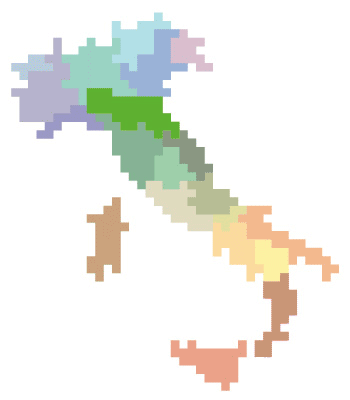
Think of it as a high-riding belt on Italy’s tall and thin boot. It’s the only region that spans from its beaches on the east all the way to the west, stopping just 10 miles short of the coast. Also think Ferrari, Maserati, Parmesan cheese, Parma ham (prosciutto), Lambrusco, Modena’s balsamic vinegar, Luciano Pavarotti and Federico Fellini. Now you’re thinking Emilia-Romagna. Maybe its wide, diverse geographic reach produces a wide, diverse array of famous food, talented people, and very fast cars.
Considered one of Europe’s richest and most developed regions, Emilia-Romagna boasts Italy’s best social services thanks to the still strong influence of the Italian communist-socialist local administrations. Efficient, inexpensive public transportation abound and cheap bicycle rentals lie just outside almost every train station. If our camper breaks down here, at least we know we’ll be able to bike, train or bus our way about to discover the varietals Pignoletto, Fortana and of course Lambrusco, which, despite its mediocre reputation of years ago, is in award-winning categories today.
Emilia-Romagna Fact Section
Pronounced: ay-MEE-lee-uh-roh-MAHN-yuh
English name: Emilia-Romagna
Capital city: Bologna
Pronounced: boh-LOHN-yuh
English name: Bologna
Population: 4,449,000
Common dialects: 13
Shares borders with: Marche, Toscana, Liguria, Piemonte, Lombardia, Veneto, Adriatic Sea
UNESCO heritage sites: 4
Official wine zones: 2 DOCG and 19 DOC
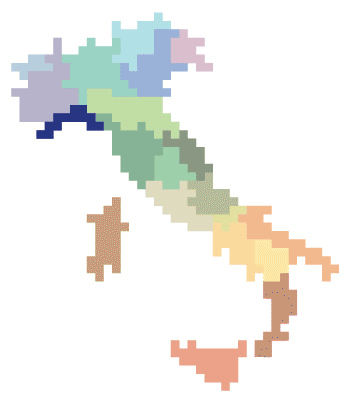
It’s a long thin strip of mountains squashed against the Mediterranean sea. Its western tip borders France, less than 5 miles from the James Bondonian casinos of Monaco and its opposite extremity touches Carrara, the white marble quarries of Tuscany. On its long south side it’s sea-centric, known for its charming villages down the Cinque Terre coastline, (some of them devastated by recent tragic flooding) and the beautiful port towns of Portofino and others all along the Italian Riviera.
Seafood and the white wine made from the Pigato grape are the stars here. On the north side, the majority bordering Piemonte, Liguria is mountainous, dotted with small isolated hill towns where fresh seafood is hard to find, hence lamb, pork and rabbit dominate the cuisine. White wine doesn’t quite do these meat dishes justice, and we are told that the local red varietal, Rossese, is the perfect marriage.
Liguria Fact Section
Pronounced: lee-GOO-ree-uh
English name: Liguria
Capital city: Genova
Pronounced: JEH-no-va
English name: Genoa
Population: 1,565,000
Common dialects: 7
Shares borders with: Piemonte, Emilia-Romagna, Toscana, Tyrrhenian Sea, France
UNESCO heritage sites: 2
Official wine zones: 8 DOC
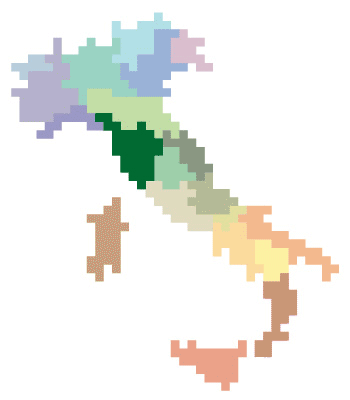
Here, we just might be talking about the most famous region of any country in the world. Ahhh…Tuscany! What’s its secret? No secret really, even if you’ve never been here before. It’s enough to have studied basic history, or to have read D.H. Lawrence or Henry James, or to have swirled a glass of Brunello, or to have visited the Renaissance section in any museum, or to have seen one of the thousands of movies made here, and you’ll know something about this place. But when you do come, talk to the Tuscans. I Toscani are extremely proud of their history and very aware of their “race”, often claiming ancestral proximity with Machiavelli, Michelangelo, Leonardo Da Vinci, Dante and The Medici Family. But you can stop them in their tracks by asking, “so, who’s famous today?” As they fumble for answers, help them out by citing the famous modern “Super Tuscans”: Sassicaia, Tignanello and Ornellaia. Then snicker.
Toscana is best known for Sangiovese, the epic grape responsible for much of the hoopla here. We’ll hunt down some local forms of the Sanguis Jovis, the “blood of Jove”, then move on and concentrate on lesser known varietals like Foglia Tonda and Colorino.
Toscana Fact Section
Pronounced: tohss-KAH-nah
English name: Tuscany
Capital city: Firenze
Pronounced: fee-REN-tzay
English name: Florence
Population: 3,742,000
Common dialects: 21
Shares borders with: Liguria, Emilia-Romagna, Lombardia, Tyrrhenian Sea, Umbria, Marche
UNESCO heritage sites: 8
Official wine zones: 11 DOCG and 41 DOC
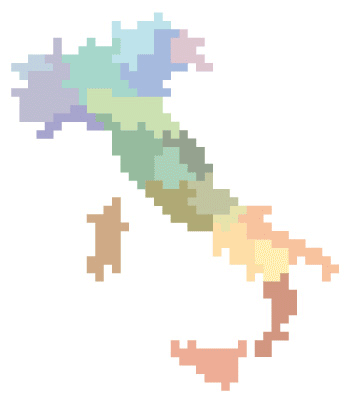
Rome, Italy’s political capital, dominates everything here to the point of forgetting the region’s name, unless you’re a “Seria A” football fan. Stretched along the west side, about halfway down the Italian peninsula, Lazio has 270 km (168 mi) of coastline on the Tyrrhenian sea. The majority of the land is rolling hills with a notable mountain range to the east boasting peaks 2400 mt (7900 ft) and higher. The climate is mild, making Lazio a desirable place to live, but as many Italians north of Rome would attest to, not a desirable place to work. I Romani are known for taking their good ol’ time getting things done. It’s a cultural thing. If you want to conduct business in Rome, just remember that work appointments should not be made before 10 am, and unless you’ve scheduled a lunch meeting, no one will be available between 12-4 (they’re having lunch), so try to get in around 5pm because at 6 they’ve left the office to go shopping. 🙂
Despite nothing getting done, The Eternal City can be a magically beautiful and glamorous city. It’s the Italian center for film and television, journalism and of course, politics. We’ll have time and space to cut open the political can of worms another day, so for now, let’s stick to Lazio’s wines. (Note: one our goals is to give you great reasons to get out of the major tourist destinations and discover the places that most people – including Italians – know little about.
). White wines dominate and are known for their uncomplicated, light, young characteristics (an interesting contrast to Lazio’s politics). We’ll be looking for the Abbuoto and the Malvasia Bianca di Candia grapes. The most interesting red for us is the Cesanese grape, that producing an uncharacteristically important and weighty, fruity red.
Lazio Fact Section
Pronounced: LAHTS-ee-o
English name: Lazio (sometimes Latium)
Capital city: Roma
Pronounced: ROH-ma
English name: Rome
Population: 5,898,000
Common dialects: 17
Shares borders with: Toscana, Tyrrhenian Sea, Umbria, Marche, Abruzzo, Molise, Campania
UNESCO heritage sites: 5
Official wine zones: 3 DOCG and 27 DOC
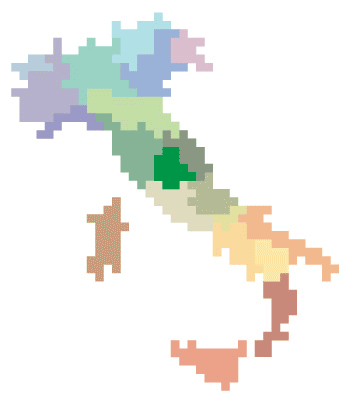
Looking at a map, it appears in dead center bulls-eye. Umbria is the green heart of Italy and the only land-locked region with no international borders. Maybe it’s these reasons that contribute to the sense of mysticism one experiences while traveling the hills and thick forests of this well-preserved paradise. As a perfect land for monasteries and saints, it’s no surprise that both St. Francis of Assisi and St. Clair were born here. Their philosophies of living simply, and off the local land, with no hurry, nor need for anything else that’s doesn’t already exist, can still be found here. For these reasons, and because of Umbria’s natural beauty similar to those of its world famous neighbor, Umbria is fast becoming the next Toscana with tourists and expats. However it’ll still be a few years before you see crowds like in Toscana.
Umbria is noted for its excellent olive oil and black truffles found in Valnerina, an area that produces 45 per cent of all the black truffles in Italy. World class wine production is not new, but recently seems to be gaining more notoriety. Umbria’s varietals include the white Grechetto di Orvieto, and the red Sagrantino of the prized Sagrantino di Montefalco.
Umbria Fact Section
Pronounced: OOM-bree-uh
English name: Umbria
Capital city: Perugia
Pronounced: pear-RUH-juh
English name: Perugia
Population: 888,900
Common dialects: 8
Shares borders with: Toscana, Marche, Lazio
UNESCO heritage sites: 2
Official wine zones: 2 DOCG and 13 DOC
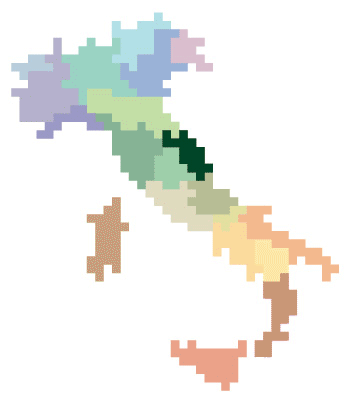
Positioned half-way down the east coast, this very hilly region acquired its name in the Late Medieval period during the unification of various local territories. A territory was sometimes referred to as a “mark” as in the Marca di Ancona. The plural is Le Marche which the where the “le” is sometimes still used.
During the period when Italy was controlled by the papal state, tax agents were often recruited from Marche as they were known to be efficient and difficult to corrupt. An old saying in these parts goes “Meglio un morto in casa che un marchigiano fuori della porta”. (“Better a death in the house than a Marchigiano tax agent at the front door”).
A mini industrial boom in the 1980’s transformed this almost exclusively agricultural area into a vibrant manufacturing center for shoes, furniture and leather production, home appliances, ship building and quality paper. But the results have not been invasive. I Marchigiani have integrated the non-agricultural with the agricultural economy almost seamlessly. Hence, the vineyards here have only improved in quality production and the rise in popularity of the native grape Verdicchio goes to prove it. Our favorite is from the Matelica area, cultivated at a higher elevation, giving it an intense, pleasant bouquet and crispness. Also in our sights, and in our hearts, the emotional grape Lacrima (Tears).
Marche Fact Section
Pronounced: MARK-ey
English name: Marche
Capital city: Ancona
Pronounced: ahn-COH-na
English name: Ancona
Population: 1,538,000
Common dialects: 14
Shares borders with: Emilia-Romagna, Toscana, Umbria, Lazio, Abruzzo, Adriatic Sea
UNESCO heritage sites: 1
Official wine zones: 5 DOCG and 15 DOC
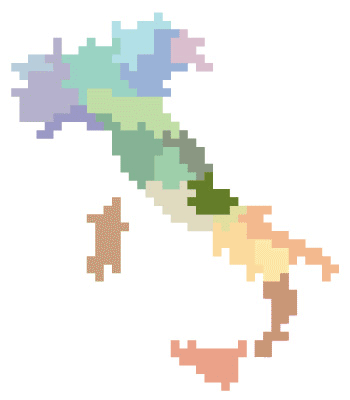
Two words describe this region: uncontaminated wilderness. Ninety-nine percent of this region is covered with mountains and hills — over one third of the region is protected parklands — and it claims 150 km of coastline along the Adriatic Sea. No wonder it’s considered an outdoor lover’s paradise. It could be called the Switzerland of the South where you can encounter chamois, wolves, bears and golden eagles. Over the centuries, the mountains have acted as a barrier maintaining Abruzzo’s pristine environment but also its many dialects, customs and cuisines. Pretty interesting considering it’s just 50 miles away from Italy’s bustling center of Rome.
Come to Abruzzo to avoid the crowds and experience some of the country’s best preserved medieval and Renaissance hill towns. Your money will be well spent here as it will help rebuild Abruzzo after the tragic earthquake in the spring of 2009, near the capital l’Aquila, which left over 300 dead, 65,000 homeless and thousands of buildings damaged. Buying a few bottles of wine is another way to help restore the economy and a good way to experience the red grape Montepulciano, responsible for the underrated deep, dark and full bodied wine of the same name. One of the white grapes on our radar is Trebbiano d’Abruzzo.
Abruzzo Fact Section
Pronounced: Ah-BROO-zoh
English name: Abruzzo
Capital city: l’Aquila
Pronounced: LAH-kwee-lah
English name: Aquila
Population: 1,322,000
Common dialects: 9
Shares borders with: Lazio, Marche, Molise, Adriatic Sea
UNESCO heritage sites: 1
Official wine zones: 1 DOCG and 8 DOC
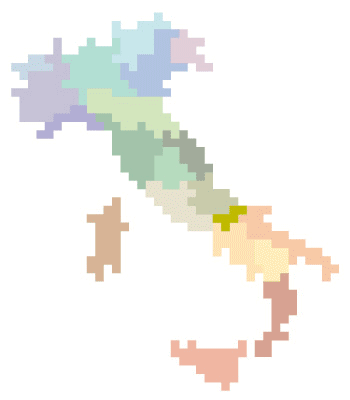
Poor, forgotten Molise. Raise your hands if you’ve heard of this region. I’ve been in Italy for over 20 years and I still haven’t met someone from Molise, let alone someone who’s traveled to Molise. The second smallest region in Italy and the newest, Molise was originally part of the former region called Abruzzi e Molise. Established in 1963, but wasn’t effective until 1970, it’s the only region was formed like an amebic division; it just kind of lopped itself off.
Low in population density at less than one third of the national average, Molise’s mountainous terrain, difficult to cultivate, has caused a population drain for most of its history. The northern border is 35 km of Adriatic coastline and only 160 km from Croatia. It’s no surprise that 5000 Italian citizens of Croatian origin live in Molise and speak their local dialect. Also in significant numbers are the Arbëreshë, a linguistic and ethnic Albanian minority. These various ethnic groups have had an obvious influence on the local cuisine, but what about the local wine? We’ll be looking forward to finding out while hunting for the autochthonous red grape Tintilia.
Molise Fact Section
Pronounced: mo-LEEZ-ay
English name: Molise
Capital city: Campobasso
Pronounced: CAMP-o-BAHSS-o
English name: Campobasso
Population: 310,500
Common dialects: 5
Shares borders with: Abruzzo, Puglia, Campania, Lazio, Adriatic Sea
UNESCO heritage sites: 0
Official wine zones: 4 DOC
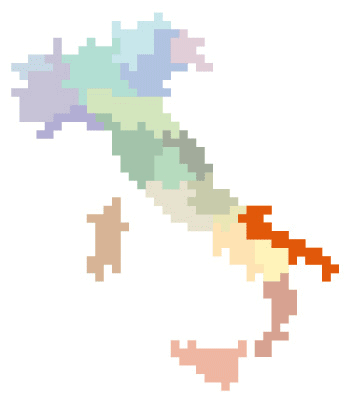
With a bit of imagination, Italy’s boot sports S&M characteristics with a very high-heel and a spur. The region of Puglia claims both of these. The spur, just south of Molise, an area called Gargano, is known for its natural beauty and protected parks. The heel part that juts out into the sea is called Salento, part of Puglia’s 860 kms (534 miles) of coastline, the most of any region on the peninsula. A seaside paradise, sharing the Ionian and Adriatic seas, the Gulf of Taranto and the Strait of Òtranto to the south, one can easily reach a beach from any point in Puglia in less than a half hour drive.
Puglia is famous for its archeological findings as it was once settled by the Illyrics and ancient Greeks. An iconic architectural structure unique to Puglia is the Trullo, an ancient circular, conical-roofed white-washed house built of stone without mortar. Their pinnacle roofs are tiled with concentric rows of grey slate and often painted with astrological or religious symbols.
The Mediterranean cuisine of pasta, bread, olive oil (the highest production in Italy), fish and vegetables dominates. Orecchiette pasta (little ear shapes) with a sauce of cima di rape (broccoli raab), seasonal in winter months, sautéed with anchovies, makes an excellent reason to visit in the off-season. All in all a visit to Puglia is like stepping back in time; it has the air of a silent film, quite fitting, as the star Rudolph Valentino was born and grew up here.
And Puglia seems to be one massive vineyard. It produces 10 per cent of all the wine Europeans drink, as the hot, dry climate is favorable to the cultivation of sugar-rich grapes, much of them sold to other producers to add density, color and increase alcohol levels in their wines. The red varietal Primitivo, one of these super-juicy grapes is the ancestor of the California Zinfandel and Negroamaro (the name emphasizing the color black in two languages, Latin and Greek).
Puglia Fact Section
Pronounced: POOL-yuh
English name: Apulia
Capital city: Bari
Pronounced: BAH-ree
English name: Bari
Population: 4,000,000
Common dialects: 13
Shares borders with: Molise, Campania, Basilicata, Tyrennian Sea, Adriatic Sea
UNESCO heritage sites: 4
Official wine zones: 4 DOCG and 28 DOC
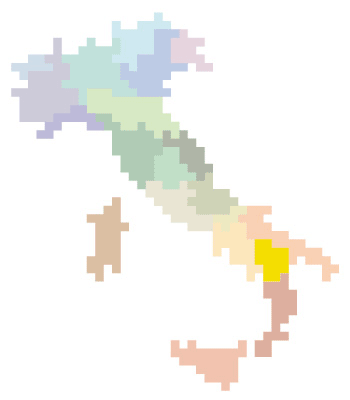
Between the toe of Calabria and the heel of Puglia, Basilicata is the instep of Italy’s boot. Despite having coastlines on two separate bodies of water (the Ionian and the Tyrennian Seas), Basilicata is not known as a coastal region. It’s the most mountainous of the southern regions, and is loaded with parks and reserves with 30 per cent as protected area. This is obvious when traveling down along the coast of Campania, its neighbor to the north, where unregulated construction makes for some unsightly seaside construction. As one crosses the border into Basilicata, the ugly construction disappears.
Archeological findings show a long history with evidence of some of the first human settlements in Italy. In the ancient Greek period it was called Lucania and is sometimes still referred to that today. (Lucania was its official name between 1932 and 1947.) Basilicata is still one of the more economically-depressed regions in southern Italy, due to emigration and poor agricultural development, but the recent discovery of petroleum, the addition of a large FIAT plant as well as the establishment of the Sassi di Matera as a UNESCO World Heritage site have helped bolster Basilicata’s economy.
One of the most fascinating cities in Italy, Matera has a historical center made of cave houses called ‘sassi’ (stones), tunneled into the tuff volcanic rock along with over 100 rock churches. The city is picturesquely situated above a rocky gorge and has been the background for many films, including Pasolini’s The Gospel According to St. Matthew and Mel Gibson’s The Passion of the Christ. In addition to the ‘sassi’ Basilicata’s wines, like those produced with the autochthonous red varietal Aglianicone, have become a draw and acquired a respected reputation. We’ll also be on the prowl for the white varietal Malvasia di Basilicata, known for its dessert style wines.
Basilicata Fact Section
Pronounced: BAH-zily-CAT-ah
English name: Basilicata
Capital city: Potenza
Pronounced: poh-TEN-sah
English name: Potenza
Population: 570,000
Common dialects: 6
Shares borders with: Calabria, Campania, Puglia, Tyrennian Sea, Ionian Sea
UNESCO heritage sites: 2
Official wine zones: 1 DOCG and 4 DOC
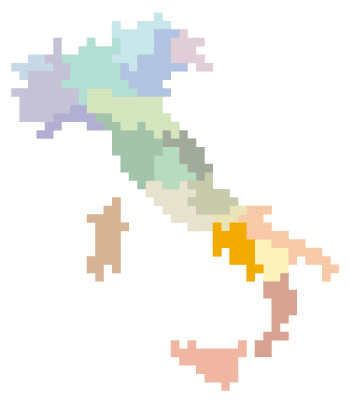
This region has seen it all: From the ancient Greeks and Romans to the Byzantine Empire, the Lombards, the Normans, the Spanish, the French, the Aragons and the Bourbons, all leaving their cultural influences in art, architecture, gastronomy and music. That’s what made Campania what it is today.
Napoli, the region’s capital, is one of Europe’s oldest cities, rich in culture, and dominated by the dark and mysterious Vesuvius. Mount Vesuvio, is loved for its beauty and feared for its power and is considered one of the most dangerous volcanoes in the world because of the 3 million people living nearby. Another Pompei just waiting to happen? Napoli is world famous for the intensity and passion of its art and music and for being the birthplace of the pizza – no tomato sauce on the original version as tomatoes didn’t exist here until they arrived from America in the 1700’s. The city masterfully juggles the refined and the popular, sacred and profane, joyful and melancholic aspects of life. Unfortunately, Campania has recently found itself on the bottom of the list regarding quality of life levels, mostly due to the decades long trash collection emergency. The Camorra, a two-hundred year old mafia-type criminal organization has its grip on this situation, but there does seem to be some progress in weakening the organization, also thanks to the reportive journalism of Roberto Saviano who’s book Gomorra was made into a powerful movie that won Best Film at the European Film Awards 2008.
Along the coastline, the heady scents of oranges, lemons and orange-blossoms waft off terraces sloping down to the sea, used for the cultivation of citrus and olive trees and of course vineyards. Among the vines, white grapes dominate the region and we’ll be looking for the autochthonal varietals Greco, Fiano and Asprinio.
Campania Fact Section
Pronounced: cahm- PAHN- ya
English name: Campania
Capital city: Napoli
Pronounced: NAH-po-lee
English name: Naples
Population: 5, 955,000
Common dialects: 5
Shares borders with: Lazio, Molise, Puglia, Basilicata, Tyrennian Sea
UNESCO heritage sites: 6
Official wine zones: 4 DOCG and 15 DOC
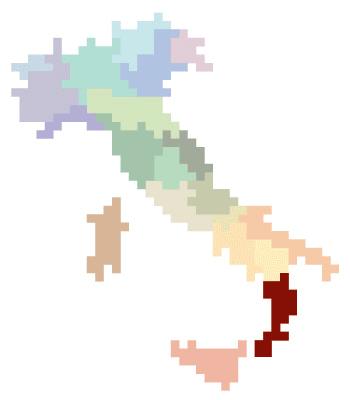
We’ve finally arrived at the toe. Calabria, almost completely surrounded by water, is naturally a sea-centric region. But with 3 different mountain ranges rising up to 2260 mt (7400 ft), crossing to the other side proves to be a bit more difficult than in flat neighboring Puglia, but well worth the effort as you’ll discover multitudes of medieval towns hiding in these mountains.
During Calabria’s course in history, there seems to have been a bit of indecision on naming this region. Its very first name was “Italia,” probably from the Italic tribes inhabiting the land. It was later changed to Brutium, then to Magna Grecia or “Great Greece” before it assumed it’s current name when it was politically joined with the Salento area of Puglia, then of the same name. It’s ancient history has left us with some of most the beautiful bronze statues in the world. The life-size Greek warrior nudes were found off the coast of Riace, near Reggio Calabria by a scuba diver in 1972.
Calabria’s harsh climate and lack of inland water over time have inspired the mantra “Do not waste food because we’re going to have a hard time getting more“. Hence Calabria is famous for its preserved meats, hot peppers and other vegetables preserved in olive oil and vinegar.
Being once “Great Greece” it’s obvious who brought over the first grapes, but the indigenous people learned the art of wine making so well that soon the wines produced here became better than those made in Greece. So the land was given yet another name: Enotria, or “Land of Wine”. According to some records, the wine Cirò, named after the place it originated, may just be the oldest wine in the world. The red wine Cirò is made with the autochthonous varietal Gaglioppo, while the white version is made with Greco Bianco. We’ll also be searching for Magliocco Canino, known for producing an elegant red wine with an excellent capacity to cellar well.
Calabria Fact Section
Pronounced: ca-LAH-bree-uh
English name: Calabria
Capital city: Catanzaro
Pronounced: ca-tan-ZAH-ro
English name: Catanzaro
Population: 1,965,000
Common dialects: 4
Shares borders with: Basilicata, Tyrennian and Ionian seas
UNESCO heritage sites: 1
Official wine zones: 9 DOC
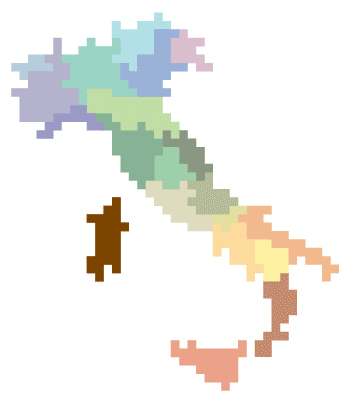
If Italy has 20 regions, Sardegna has hundreds. Known as an “island-continent” by the locals, Sardegna is where one breathes the history of the world. The Phoenicians, Romans, Byzantines, Aragons, Spanish and Hapsburgs all have been colonizers of this Mistral wind swept land. It’s the second largest Mediterranean island (only Sicily is larger) and is closer to Africa than it is to mainland Italy – physically and culturally.
Sardegna is the sum of: nature, man, sea, land, and “islandness”. They can’t be separated. The extreme differences in terrain sweep from north to south, from the tough, lush granite of Gallura, the cradle of the white varietal Vermentino Bianco. Half-way down the east coast, among mountains and variable micro-climates, in the province Ogliastra, we find the red varietal Cannonau with its 600 year connection to the Spanish Granacha. Time well spent as it has since found a unique identity in its Sardinian terroir. Travelling to the opposite, wild, central-west coast, we find the white grape Vernaccia di Oristano: dry, sea-salty and extreme, a perfect match with the strong taste of bottarga, a prized dried mullet caviar. The extreme southwest coast is the home of the elegant red varietal Carignano, thriving in the sandy soils of Sulcis, as ancient as the sound of its name.
Stay in Sardegna for a few weeks; it will leave you in awe and you’ll begin to understand the words of David Herbert Lawrence: “This land is unlike any other place. A haunting space around, and far to travel, nothing is finite, nothing definite. It is freedom itself.” (The Sea and Sardinia, 1921).
Sardegna Fact Section
Pronounced: sar-DAY-nya
English name: Sardinia
Capital city: Cagliari
Pronounced: CAL-yah-ree
English name: Cagliari
Population: 1,675,000
Common dialects: 15
Island in the Tyrennian and Mediterranean seas
UNESCO heritage sites: 1
Official wine zones: 1 DOCG and 17 DOC
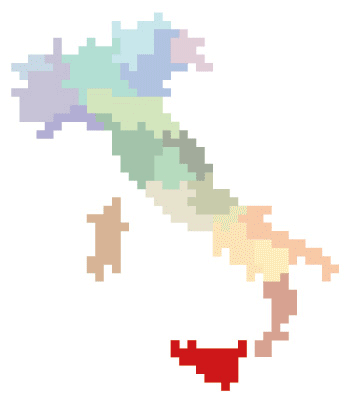
Drama kings and queens need a birthplace and training grounds. From the exquisitely formal, cordial encounters between strangers on the street, to the the act of buying an eggplant at the market or ordering a granita al caffé in an ice cream parlor, everything here is theater.
Sicilians have seen and experienced the length and breadth of world history and it seems to ooze from their beings. Spending some time here, one develops a poignant sense of life to be lived in the now, mixed with a thick air of futility. A local high school teacher and poet named Gesualdo Bufalino (1920-1996) summed up Sicilian life in this potent phrase: “Every Sicilian, as a fact, is an unrepeatable, moral and psychological ambiguity. And because of this, the entire island itself is a mix of death and of light. The more the death, the more flagrant the light, making it seem unbelievable, and how unacceptable death can be.”
Sicilia, the Mediterranean’s largest island, is an autonomous region (one of Italy’s 5) with seven UNESCO World Heritage Sites. Once called the Kingdom of Trinacria, refering to the triangular shaped island, the surreal three-legged medusa head symbol still flies on its flag. Mount Etna, one of the world’s most active volcanoes and Europe’s highest, dominates the eastern side of the island. Its slopes are the home of the red and white grapes Nerello Mascalese and Carricante, the former producing a dry, “minerally”, full-bodied wine. Nero d’Avola, a red indigenous grape expresses itself handsomely in the southern Cerasuolo di Vittoria region, near Ragusa. On the western coast, near Trapani in the Alcamo area, we find Sicilia’s oldest autochthonous grape, Inzolia, producing a delicate dry white, and also the fortified, world famous Marsala wine.
Sicilia Fact Section
Pronounced: see-CHEEL-ya
English name: Sicily
Capital city: Palermo
Pronounced: pa-LAIR-moh
English name: Palermo
Population: 5,057,000
Common dialects: 10
Island in Mediterranean seas
UNESCO heritage sites: 7
Official wine zones: 1 DOCG and 23 DOC